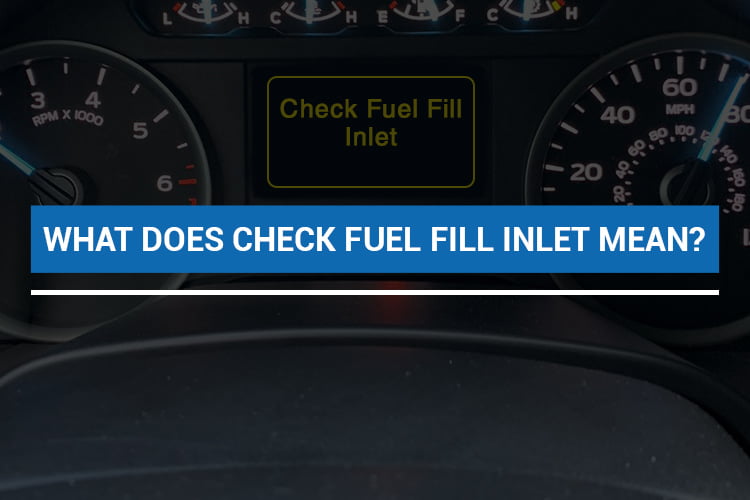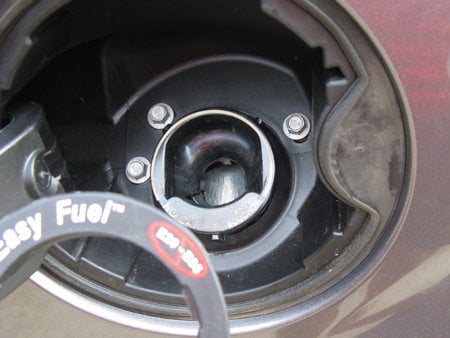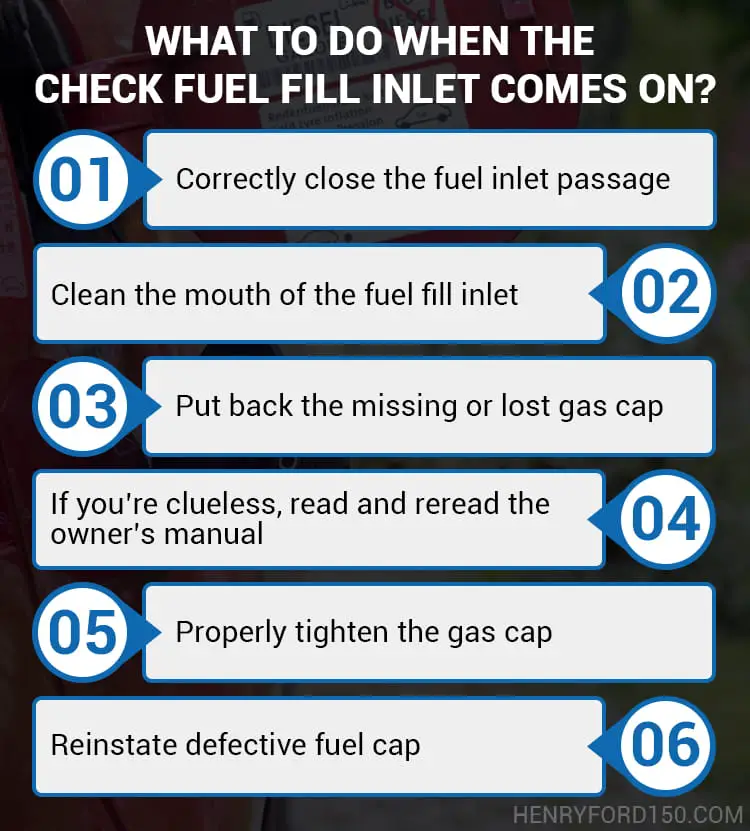You must have noticed the ‘check fuel fill inlet’ caution on the dashboard. Do not be baffled. That notification usually points toward a problem with your car’s EVAP (Evaporative Emission Control) system.
The check fuel fill inlet indication in your vehicle could also hint towards other issues involving the fuel tank or cap. These problems more often than not comprise a loosely fitted gas cap, a leaking fuel inlet pipe, and so on.
Continue reading to thoroughly understand the ‘check fuel fill inlet’ sign and practical solutions to the above problems.

Fuel Fill Inlet: An Overview
If your Ford dashboard features a message panel, then it’ll display warning signs periodically. And one such cautionary message that you’ll often see is ‘check fuel fill inlet.’ You might be a bit amazed and taken aback, especially if you’ve never seen the warning message before.
However, I’d advise you not to ignore the ‘check fuel fill inlet’ notification even if you don’t understand the same. To realize the meaning of this message, you’ll first need to have a fair idea about the fuel fill inlet.
What is the fuel fill inlet?
In short, the passageway in your vehicle through which you supply gasoline to your car is called the fuel fill inlet. This fuel inlet essentially comprises an inlet channel leading to your car’s gas tank and the gas lid covering. The fuel fill inlet is a crucial part of your truck as the conduit lets you feed gas to the vehicle. On the other hand, when the dashboard flashes the ‘check fuel fill inlet’ signal, it’s this component that you should check.

Now that you know what this sign means, there’s no need to become alarmed the next time you see the message. Instead, you’d want to check out your pickup’s fuel fill inlet to determine what made the dashboard display the caution.
What is a fuel fill inlet cap, and why is it important?
Fuel fill inlet cap
The fuel inlet cap (also known as the gas cap or fuel cap) serves as a protective covering lid for the fuel fill inlet of the vehicle or pickup. It tends to be an indispensable component of the EVAP system in your Ford vehicle. The EVAP mechanism hermetically seals your car’s fuel tank and inlet, thereby preventing the volatile gasoline from vaporizing and escaping.
Why is the fuel fill inlet cap important?
If you don’t tighten the fuel cap or the lid somehow becomes defective, it results in low mileage, gasoline leaks, and other EVAP issues. Nevertheless, firmly locking the gas cap with the fuel inlet creates a vacuum seal, enabling pressurized gasoline to flow smoothly throughout the system. Additionally, an adequately fastened fuel cap prevents gasoline that contains different hydrocarbons from evaporating and polluting the atmosphere.
Symptoms of defective fuel fill inlet cap
Like all other vehicle components and parts, the fuel inlet lid is susceptible to wear and tear. Over time the fuel cap becomes faulty or damaged, which means its vacuum sealing capability gets compromised slowly and gradually.

Following are some telltale signs indicative of a damaged fuel cap:
- Cap doesn’t lock properly or comes unstuck after closing shut
- Your car reeks of gasoline (the fuel vapors escape out owing to the lack of effective sealing)
- ‘Check engine light’ switches on
How about a capless fuel fill inlet?
A capless fuel system does away with the hassle of removing and refastening the lid simply because it doesn’t have one. You just have to pop in the gasoline nozzle for fueling, and on withdrawing the plunger, the spring-loaded closure seals the latch. Capless fuel inlets check fuel pilferage and escaping of gas vapors and splashbacks during refueling.
Many recent Ford vehicle models with capless fuel inlets also flash the ‘check fuel inlet’ message if there’s an issue with the inlet. So you can consult this guide even if you own a Ford vehicle that features a capless fuel inlet system.
Check Fuel Fill Inlet: What Does It Mean?
While driving your Ford-150, you may have noticed the “check fuel inlet” indication on the vehicle’s dashboard. This warning mainly indicates that there’s a problem with the gas cap, which covers the fuel fill inlet.

Faulty gas caps or loosely fitted fuel caps are two chief causes that make the warning light switch on. Nevertheless, several other reasons could lead to the check fuel inlet indicator light turning on. Following are some other causes that could activate the check fuel fill inlet warning light:
- Broken or busted gasoline cap
- You’ve tightened the cap excessively
- The gas cap is sitting loosely on the fuel inlet’s mouth or opening
- You have not closed the cap properly
- Accumulation of debris on the fuel cap
- Leakage of vacuum pressure in the fuel inlet
- Misplaced gasoline cap (this usually happens after refueling)
Apart from F150, two other Ford vehicles mainly show the ‘check fuel fill inlet’ caveat on the dashboard are Ford Fusion and Ford Escape. The meaning behind that warning sign is almost the same between vehicles.
Read more: Wrench Light On Ford: What Is It? [Answered]
Is It Safe to Drive Around with the “Fuel Fill Inlet” Warning On?
If you see the fuel fill inlet notification displayed for the first time, you can keep on driving your vehicle. However, if you repeatedly see the message on the dashboard, you should sit up and take notice. In such a scenario, continuing to drive your vehicle decreases gas mileage (and increases fuel expenses) and enhances environmental pollution.
If you continue to drive your pickup without doing anything about the ‘check fuel inlet’ notifications, then:
- Gasoline will evaporate from the fuel tank into the environment, causing pollution
- Your car’s mileage will gradually come down
- You’ll have to spend more on gas on average
- The EVAP system will experience more severe issues
Surely replacing the gas cap or cleaning the fuel inlet is less troublesome than putting up with the above problems.
What To Do When The Check Fuel Fill Inlet Comes On?
I’ve listed and discussed the possible reasons that cause the check fuel inlet warning light to switch on. This section will explain the answers to the question ‘How do I fix the check fuel fill inlet?’

Correctly close the fuel inlet passage
Pull over your car when you see the “check fuel fill inlet” text on the dashboard. Step out of your vehicle and ensure that the cap is fitted rightly. Since the gasoline in the fuel tank contains harmful pollutants and is highly volatile, the fuel will vaporize if the lid isn’t properly closed.
Clean the mouth of the fuel fill inlet
The fuel fill inlet opening is prone to attracting dirt and grime causing debris to build up around the mouth. Accumulated debris prevents the flaps on the fuel inlet from closing firmly, which could cause leakage. If you’re not comfortable doing it yourself, you can ask the auto service station mechanic to clean the fuel inlet.
Put back the missing or lost gas cap
Maybe you were in a hurry to leave after refueling your pickup on the road the last time. You remembered that you forgot to put the cap back over the fuel inlet when you saw the cautionary sign. Replace the missing fuel cap as soon as possible to prevent pollutants from infiltrating the EVAP system or leakage of gasoline.
If you’re clueless, read and reread the owner’s manual
Another practical way to get around the check fuel fill inlet issue is to go through the owner’s manual thoroughly. If you’re clueless about what to do, reading the manual could offer you ideas on how to fix the problem.
Properly tighten the gas cap
More often, a loosely positioned gas cap could lead to EVAP system problems. Tighten the cap slightly with a tool or manually, and cover the lid with a clean and dry piece of cotton. If you hear a soft clicking sound turning the cap clockwise, you’ll realize the lid has closed perfectly.
Reinstate defective fuel cap
You should replace a defective fuel cap or a damaged flap right away for vacuum sealing the fuel reservoir.
If you’re still unable to turn off ‘check fuel fill’ by yourself after trying the solutions mentioned above, you might need an ASE-certified mechanic to resolve the issue. Your technician will either clean the fuel inlet mouth and the fuel cap or change the damaged cap. Additionally, he is the right professional who can effectively deal with a vacuum pressure leak.
Read more: Ford SYNC Phone Button Not Working: Quick Fix Guide
How much does it cost to fix a fuel fill inlet?
You may automatically assume that you’ll have to spend a lot of money fixing a fuel fill inlet problem. However, you’ll be pleasantly surprised to learn that you’ll have to expend moderately for solving the issue. Even if you engage a professional in diagnosing and resolving the problem, you’ll not have to pay a fortune.
For example, you’ll need to pay around $75-$80 for a defective or damaged fuel cap replacement.
Final Thoughts
After going through this guide, I hope you’ll know exactly what to do when you spot the ‘check fuel fill inlet’ warning. Once you resolve the problem, it may take a while before the indicator light, and the message goes off. So instead of worrying, continue driving for some time, and the caution will turn off in due course.